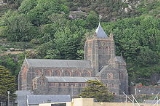
St John's Church Barmouth
Encyclopedia
St John's Church, Barmouth
, Gwynedd
, Wales
was built between 1889 and 1895 and designed by the Chester
architects Douglas & Fordham. The foundation stone was laid by Princess Beatrice of the United Kingdom
. Majority of construction costs was donated by Mrs Sarah Dyson Perrins in memory of her husband James Dyson Perrins (father of Charles William Dyson Perrins) of Lea & Perrins
.
The church belongs to the Church in Wales
. It is a grade II* listed building, and was given this status by CADW
on 31 January 1995. It is one of four church buildings administered by the Benefice
of Llanaber
and Barmouth
with Caerdeon and Bontddu
.
. This church was built in the town to accommodate an increasing population since the ancient church in Llanaber
is over a mile away from the center of Barmouth.
During this period the railways had not reached this part of the Welsh coast and as such Barmouth was still reliant on the maritime industry. This soon changed in the 1860s with the arrival of the railways resulting in a vast increase of tourists into the area.
Soon after the Reverend Edward Hughes became rector of the parish of Llanaber and Barmouth in 1887 he realised that Barmouth needed a larger place of worship that both the churches of Llanaber and St David's could not provide. Many trials were carried out in St David's to try and increase the seating capacity but these attempts proved fruitless.
During 1887 Reverend Hughes proposed the idea of building a larger place of worship to the Churchwardens and the Parochial Church Council who agreed and the work of finding a suitable location began.
With Barmouth's geographical location between the mountains and sea, building locations were limited. However a donation of a rocky precipice above the town was accepted as the final choice.
A design by architects Douglas & Fordham was chosen and fundraising efforts begun. An unexpected donation of £15,000 from Mrs Sarah Perrins, widow of James Dyson Perrins and mother of Charles William Dyson Perrins was greatly received and provided funding for the chancel, central tower, lady chapel and vestry to be built as a memorial to her late husband. Mrs Sarah Perrins and her family owned a holiday home in Barmouth called Plas Mynach
and would have been aware of the need to build a larger church.
St John's took seven years to build between the laying of the foundation stone in 1889 by Princess Beatrice of Battenburg
to consecration in November 1895 by Bishop Cambell of Bangor. There were some setbacks during the construction stages. most notably during the evening of September 11th 1891. During this stage the church was almost finished, the roofs had not yet been slated, the tower was almost completed. At some point during the evening the tower collapsed into the church destroying most the un-slated roofs and most of the walls on the mountainside of the building. Douglas and Fordham blamed the collapse on blasting operations behind the church that were aimed at obtaining more light into the building.
St John's was finally rebuilt and furnished due to the financial kindness of Mrs Perrins and her family.
sculptor Bertel Thorvaldsen
's font in Copenhagen Cathedral
and is sculpted out of pure marble.
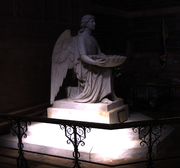
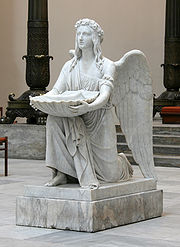
.
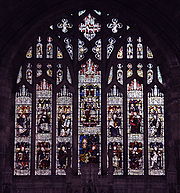
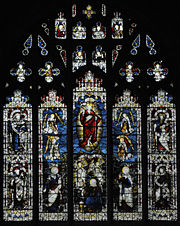 The Main East Window shows Christ in His Majesty with disciples and St John the Evangelist. The West window depicts the Risen Christ with Angels. The side windows of the Sanctuary show various scenes of the resurrection: Easter Morning, Woman at the Tomb, Christ with Doubting Thomas and the Charge to St Peter. The three windows of the Lady Chapel show the Annunciation and the Nativity.
The Main East Window shows Christ in His Majesty with disciples and St John the Evangelist. The West window depicts the Risen Christ with Angels. The side windows of the Sanctuary show various scenes of the resurrection: Easter Morning, Woman at the Tomb, Christ with Doubting Thomas and the Charge to St Peter. The three windows of the Lady Chapel show the Annunciation and the Nativity.
Funds for financing the organ were donated by Mrs Perrins' daughter Mrs Sarah Gertrude Potter and since the family were from the Worcester area Nicholson & Co
were a natural choice to build the instrument. The organ was built at the Nicholson factory at Palace Yard, Worcester and shipped to Barmouth in large containers by train. The instrument is a three manual organ with a pedal division. It has a total of 34 stops Divided between the manuals in the following configuration:
Each Manual has three combination pedals each.
The Organ also has the following couplers:
and a Tremblant on the Swell.
The greatest treasure of this organ however is its action. For the Swell, Choir and Pedals traditional Tracker action
is used, however, the Great uses a Barker Lever
pnumatics system.
Since it was installed in St Johns in 1895 the organ has not had a major overhaul and except for being cleaned in the 1970s and undergoing annual tuning an maintenance the only modification has been to incorporate a "Discus" electric blower system by Watkins and Watson in the basement some time in the 1950s. The organ is in such an unaltered and original state that it can still be hand pumped by three volunteers when required!
Prior to 1895 organs in churches in the surrounding area were virtually unheard of, Dolgellau was the only church in the locality that had a barrel organ to accompany services. Indeed at the time of its construction this organ was almost as big as the largest organ in North Wales which was located in Bangor Cathedral. By today, this organ is still one of the largest in North Wales (probably ranking between fourth and sixth largest).
Nicholson & Co must have made a remarkable impression with this instrument, over the next 20 years they installed four other pipe organs in churches and chapels in Barmouth alone - only two of these Nicholson organs (apart from this one) remain in Barmouth, one is located in St David's Church and the other one is located in Christ Church.
Barmouth
Barmouth ; Y Bermo ) is a town in the county of Gwynedd, north-western Wales, lying on the estuary of the River Mawddach and Cardigan Bay.The town is served by Barmouth railway station.- History :...
, Gwynedd
Gwynedd
Gwynedd is a county in north-west Wales, named after the old Kingdom of Gwynedd. Although the second biggest in terms of geographical area, it is also one of the most sparsely populated...
, Wales
Wales
Wales is a country that is part of the United Kingdom and the island of Great Britain, bordered by England to its east and the Atlantic Ocean and Irish Sea to its west. It has a population of three million, and a total area of 20,779 km²...
was built between 1889 and 1895 and designed by the Chester
Chester
Chester is a city in Cheshire, England. Lying on the River Dee, close to the border with Wales, it is home to 77,040 inhabitants, and is the largest and most populous settlement of the wider unitary authority area of Cheshire West and Chester, which had a population of 328,100 according to the...
architects Douglas & Fordham. The foundation stone was laid by Princess Beatrice of the United Kingdom
Princess Beatrice of the United Kingdom
The Princess Beatrice was a member of the British Royal Family. She was the fifth daughter and youngest child of Queen Victoria and Prince Albert. Juan Carlos, King of Spain, is her great-grandson...
. Majority of construction costs was donated by Mrs Sarah Dyson Perrins in memory of her husband James Dyson Perrins (father of Charles William Dyson Perrins) of Lea & Perrins
Lea & Perrins
Lea & Perrins is a United Kingdom based food division of the H.J. Heinz Company, originating in Worcester, England, with a subsidiary in the United States which manufactures Lea & Perrins in New Jersey...
.
The church belongs to the Church in Wales
Church in Wales
The Church in Wales is the Anglican church in Wales, composed of six dioceses.As with the primus of the Scottish Episcopal Church, the Archbishop of Wales serves concurrently as one of the six diocesan bishops. The current archbishop is Barry Morgan, the Bishop of Llandaff.In contrast to the...
. It is a grade II* listed building, and was given this status by CADW
Cadw
-Conservation and Protection:Many of Wales's great castles and other monuments, such as bishop's palaces, historic houses, and ruined abbeys, are now in Cadw's care. Cadw does not own them but is responsible for their upkeep and for making them accessible to the public...
on 31 January 1995. It is one of four church buildings administered by the Benefice
Benefice
A benefice is a reward received in exchange for services rendered and as a retainer for future services. The term is now almost obsolete.-Church of England:...
of Llanaber
Llanaber
Llanaber is a village in western Wales, near the resort of Barmouth.It is served by Llanaber railway station....
and Barmouth
Barmouth
Barmouth ; Y Bermo ) is a town in the county of Gwynedd, north-western Wales, lying on the estuary of the River Mawddach and Cardigan Bay.The town is served by Barmouth railway station.- History :...
with Caerdeon and Bontddu
Bontddu
Bontddu, Dolgellau, Gwynedd, Wales is a small settlement east of Barmouth.Local tourism information describes a popular walk in the area of Bontddu:- External links :**...
.
History
In 1830 a new church was finally opened in Barmouth down by the quayside dedicate to Saint DavidSt David's Church, Barmouth
As late as 1824, the Parish Church was the only Anglican place of worship in the parish. The influence of visitors at that time was already increasing and the Rector the Revd T G Roberts, was not slow to perceive the necessity of building a new church for the benefit of those English visitors who...
. This church was built in the town to accommodate an increasing population since the ancient church in Llanaber
St Mary and Bodfan
St Mary and Bodfan Church is a church located in the village of Llanaber in Wales. St Mary and Bodfan is a Grade 1 listed building, which despite substantial restoration work in 1860,is an almost perfectly preserved 13th century building with lancet windows and arch-braced collar beams to the...
is over a mile away from the center of Barmouth.
During this period the railways had not reached this part of the Welsh coast and as such Barmouth was still reliant on the maritime industry. This soon changed in the 1860s with the arrival of the railways resulting in a vast increase of tourists into the area.
Soon after the Reverend Edward Hughes became rector of the parish of Llanaber and Barmouth in 1887 he realised that Barmouth needed a larger place of worship that both the churches of Llanaber and St David's could not provide. Many trials were carried out in St David's to try and increase the seating capacity but these attempts proved fruitless.
During 1887 Reverend Hughes proposed the idea of building a larger place of worship to the Churchwardens and the Parochial Church Council who agreed and the work of finding a suitable location began.
With Barmouth's geographical location between the mountains and sea, building locations were limited. However a donation of a rocky precipice above the town was accepted as the final choice.
A design by architects Douglas & Fordham was chosen and fundraising efforts begun. An unexpected donation of £15,000 from Mrs Sarah Perrins, widow of James Dyson Perrins and mother of Charles William Dyson Perrins was greatly received and provided funding for the chancel, central tower, lady chapel and vestry to be built as a memorial to her late husband. Mrs Sarah Perrins and her family owned a holiday home in Barmouth called Plas Mynach
Plas Mynach
Plas Mynach is a large country house in Barmouth, Gwynedd, Wales. It is a Grade II* listed building standing in a prominent position overlooking the sea.-History:...
and would have been aware of the need to build a larger church.
St John's took seven years to build between the laying of the foundation stone in 1889 by Princess Beatrice of Battenburg
Princess Beatrice of the United Kingdom
The Princess Beatrice was a member of the British Royal Family. She was the fifth daughter and youngest child of Queen Victoria and Prince Albert. Juan Carlos, King of Spain, is her great-grandson...
to consecration in November 1895 by Bishop Cambell of Bangor. There were some setbacks during the construction stages. most notably during the evening of September 11th 1891. During this stage the church was almost finished, the roofs had not yet been slated, the tower was almost completed. At some point during the evening the tower collapsed into the church destroying most the un-slated roofs and most of the walls on the mountainside of the building. Douglas and Fordham blamed the collapse on blasting operations behind the church that were aimed at obtaining more light into the building.
St John's was finally rebuilt and furnished due to the financial kindness of Mrs Perrins and her family.
Font
The Font located at the back of the church is a free-copy of DanishDenmark
Denmark is a Scandinavian country in Northern Europe. The countries of Denmark and Greenland, as well as the Faroe Islands, constitute the Kingdom of Denmark . It is the southernmost of the Nordic countries, southwest of Sweden and south of Norway, and bordered to the south by Germany. Denmark...
sculptor Bertel Thorvaldsen
Bertel Thorvaldsen
Bertel Thorvaldsen was a Danish-Icelandic sculptor of international fame, who spent most of his life in Italy . Thorvaldsen was born in Copenhagen into a Danish/Icelandic family of humble means, and was accepted to the Royal Academy of Arts when he was eleven years old...
's font in Copenhagen Cathedral
Church of Our Lady (Copenhagen)
The Church of Our Lady is the cathedral of Copenhagen and the National Cathedral of Denmark. It is situated on Vor Frue Plads and next to the main building of the University of Copenhagen....
and is sculpted out of pure marble.


Lectern
The lectern was made in Frome. It is made of wrought iron and copper and represents the Sower and the Seed.Bell tower
The tower contains 8 bells by Mear and Stainbank of Whitechapel in London. There is also a clock mechanism in the bell ringing chamber built in 1897, this mechanism also plays the Westminster Chimes using some of the eight bells.Stained glass windows
St John's has nine stained glass windows by CE KempCharles Eamer Kempe
Charles Eamer Kempe was a well-known Victorian stained glass designer. After attending Twyford School, he studied for the priesthood at Pembroke College, Oxford, but it became clear that his severe stammer would be an impediment to preaching...
.


Organ
St John's church was designed by John Douglas and Daniel Fordham as previously mentioned. Unlike most churches, their design incorporated a purpose built area for the organ that was to be installed in the church upon completion of the building and not a design that considered the organ an afterthought. This has resulted in an organ that has all parts easily accessible without the need for large panels or pipework to be removed during tuning and maintenance.Funds for financing the organ were donated by Mrs Perrins' daughter Mrs Sarah Gertrude Potter and since the family were from the Worcester area Nicholson & Co
Nicholson & Co (Worcester) Ltd
Nicholson & Co Ltd is a company that manufactures pipe organs.The Nicholson's were a family of organ builders originating from Rochdale, Lancashire in the North of England. When John Nicholson moved to Worcester in 1841 he obtained permission from the Dean and Chapter of Worcester Cathedral to...
were a natural choice to build the instrument. The organ was built at the Nicholson factory at Palace Yard, Worcester and shipped to Barmouth in large containers by train. The instrument is a three manual organ with a pedal division. It has a total of 34 stops Divided between the manuals in the following configuration:
| Division | Stop Name | Length |
|---|---|---|
| Swell | Clarion | 4 ft |
| Oboe | 8 ft | |
| Cornopean | 8 ft | |
| Mixture | 3 Rks | |
| Wald Flute | 4 ft | |
| Harmonic Piccolo | 2 ft | |
| Viol D'Orchestre | 8 ft | |
| Voix Celeste | 8 ft | |
| Gamba | 8 ft | |
| Lieblich Gedackt | 8 ft | |
| Bourdon | 16 ft | |
| Open Diapason | 8 ft | |
| Great | Trumpet | 8 ft |
| Mixture | 4 Rks | |
| Fifteenth | 2 ft | |
| Twelfth | 3 ft | |
| Harmonic Flute | 4 ft | |
| Principal | 4 ft | |
| Clarabella | 8 ft | |
| Keraulophon | 8 ft | |
| Bourdon | 16 ft | |
| Small Open Diapason | 8 ft | |
| Large Open Diapason | 8 ft | |
| Choir | Clarionet | 8 ft |
| Piccolo | 2 ft | |
| Suabe Flute | 4 ft | |
| Dolce | 8 ft | |
| Clarabella | 8 ft | |
| Dulciana | 8 ft | |
| Gamba | 8 ft | |
| Pedals | Principal | 8 ft |
| Violoncello | 8 ft | |
| Bourdon | 16 ft | |
| Open Diapason | 16 ft |
Each Manual has three combination pedals each.
The Organ also has the following couplers:
- Super Octave to Pedal
- Choir to Great
- Swell to Great
- Swell to Choir
- Pedal to Swell
- Pedal to Great
- Pedal to Choir
and a Tremblant on the Swell.
The greatest treasure of this organ however is its action. For the Swell, Choir and Pedals traditional Tracker action
Tracker action
Tracker action is a term used in reference to pipe organs and steam calliopes to indicate a mechanical linkage between keys or pedals pressed by the organist and the valve that allows air to flow into pipe of the corresponding note...
is used, however, the Great uses a Barker Lever
Barker lever
The Barker lever is a pneumatic system which multiplies the force of a finger on the key of a tracker pipe organ. It employs the wind pressure of the organ to inflate small bellows called "pneumatics" to overcome the resistance of the pallets in the organ's wind-chest . This lever allowed for the...
pnumatics system.
Since it was installed in St Johns in 1895 the organ has not had a major overhaul and except for being cleaned in the 1970s and undergoing annual tuning an maintenance the only modification has been to incorporate a "Discus" electric blower system by Watkins and Watson in the basement some time in the 1950s. The organ is in such an unaltered and original state that it can still be hand pumped by three volunteers when required!
Prior to 1895 organs in churches in the surrounding area were virtually unheard of, Dolgellau was the only church in the locality that had a barrel organ to accompany services. Indeed at the time of its construction this organ was almost as big as the largest organ in North Wales which was located in Bangor Cathedral. By today, this organ is still one of the largest in North Wales (probably ranking between fourth and sixth largest).
Nicholson & Co must have made a remarkable impression with this instrument, over the next 20 years they installed four other pipe organs in churches and chapels in Barmouth alone - only two of these Nicholson organs (apart from this one) remain in Barmouth, one is located in St David's Church and the other one is located in Christ Church.

